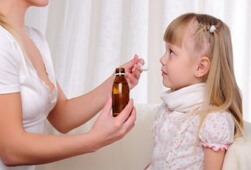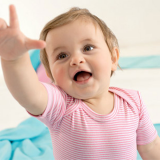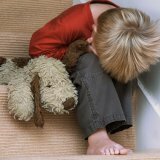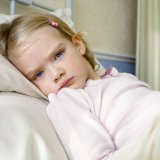Pneumonia without fever in a child
 Pneumonia without temperature in a child is a disease that is typical for children with weak, immature mechanisms of the immune system. This option is still called quiet or secretive. The special danger of pneumonia without temperature for children is that a child is often unable to adequately explain his complaints to adults or is so small that he does not know how to speak at all.
Pneumonia without temperature in a child is a disease that is typical for children with weak, immature mechanisms of the immune system. This option is still called quiet or secretive. The special danger of pneumonia without temperature for children is that a child is often unable to adequately explain his complaints to adults or is so small that he does not know how to speak at all.
Pneumonia in a child without temperature, does not carry an infectious burden for others - not being contagious, and can not be transmitted from person to person on the airborne path, but has the nature of the course of infection.
This disease is classified into the following types:
• Focal - is more often diagnosed in the age range 1-3 years. Pathology, being secondary and, mainly, as a result of infection with infectious diseases( ARVI, bronchitis, laryngitis, influenza or parainfluenza).Symptomocomplex: dry and deep cough. It is treated for 2-3 weeks with the use of antibiotic drugs. The most common form of childhood disease, rarely focal left-sided pneumonia in a child without fever is manifested, more often it is on the right side.
• Segmental - affects the lungs in part, while the baby does not eat well, refuses it, does not want to play, does not sleep well. Coughing can practically not occur, because of what often this species is difficult to detect from the first days.
• Shared - captures one or more lobes of the lung.
• Drain - when the process from several segments-segments merges into one large lesion.
• Total - damage to the entire lung tissue.
• Lobar - can equally affect both lungs. In the area of the projection of the lung and abdominal pain zone, there is a moist cough with rusty sputum, red tears and one-sided redness of the face.
• Staphylococcal - more common in newborns and early childhood. The main symptom-complex include: shortness of breath, vomiting, coughing, ear-rattling. With timely-applicable, adequate treatment, the disease recedes after about 2 months, followed by a rehabilitation course for the baby from 10 days.
If the lesion is localized in only one lung, then this is a one-sided lesion( left-sided pneumonia in a child without temperature or right-sided), both bilateral pneumonia in a child without temperature. Also, the primary condition is distinguished - the development of the disease itself, the secondary one - as a result of the previously transmitted infectious disease.
Symptoms of pneumonia in a child without temperature form the following classification cohort:
• Hospital - the child becomes ill after having been hospitalized for three days or three days after discharge.
• Community-acquired - an infection that has nothing to do with medical institutions. The most common kind. It is subdivided with or without impairment of immunity.
• From medical interventions - pathogens are introduced into the human body during procedures, operations, provoke frequent hospitalizations, hemodialysis, parenteral administration of medicines, residents of nursing homes are exposed.
• Aspiration - manifested when foreign particles, pieces of food or liquid, infectious sputum from the nasopharynx enter the respiratory tract.
• Ventilation - early( up to 72 hours) and late( after 96 hours), when a person is on the ventilator.
• Intrauterine - congenital form, revealed in the first 3 days from the appearance of the baby to the light.
• Cytostatic - when taking cytostatic drugs.
• Atypical form - with etiopathogenetic rare types of pathogens( mycoplasma, chlamydia).
The incidence of children is explained by the following factors:
- immature parenchyma of the lungs;
- the airways are narrow;
- the mucous membranes are saturated with blood vessels, which is why they tend to swell instantly, which leads to deterioration of ventilation functions;
- ciliated epithelium is not able to adequately eliminate sputum and infection easily penetrates, settles and multiplies;
- due to underdevelopment of additional sinuses of the nose, lower nasal passage, immaturity of local factors - air does not warm warmly when inhaled and is not cleaned to the required degree;
- horizontally arranged ribs;
- immaturity of alveoli and surfactant;
- in the roots of the lungs a rich vascularization;
- the length and width of the individual bronchi differs from those of adults, which creates unequal drainage conditions. It differs from adults by lightning speed of the current, in infants it is rarely contagious, more often secondary - as a complication of tonsillitis, bronchitis, laryngitis.
Pneumonia without temperature in a child is risky for life by the fact that breathing is shallow, lungs are less well ventilated and this is a wonderful soil for the development of etiopathogenic agents.
Pneumonia without temperature in a child: causes of
Pneumonia without temperature in a child can cause:
- Bacteria. The most common etiopathogenetic agent is pneumococcus, as it is the most trophic to the lung tissue. Staphylococcus, streptococcus, chlamydia, mycoplasmas, Legionella, Klebsiella, and Escherichia can also act as provocateurs.
- Viruses. Occupy 50% of the etiological cohort. This is the wand of Afanasyev-Pfeiffer, influenza, parainfluenza, adenovirus, herpes, chickenpox virus, PC virus, cytomegalovirus.
- Fungi. Rarely does fungal contamination occur( for example, candidiasis or aspergillosis).In general, this subtype of lesion is typical for strong changes in immunity and there is a very severe course of the disease.
- Parasites. Pathogenetically emerges a picture when the penetration of parasites into the lungs to eliminate the latter occurs accumulation of eosinophils. As a consequence, an eosinophilic infiltrate is formed. Representatives of this lesion may act - ascarids, pulmonary flukes, pork tapeworm, echinococcus.
There are a number of etiopathogenetic factors in which the causes of lowering the body's defensive-defense forces are very diverse:
- infant and young age;
- uncontrolled intake of an antibiotic group of medicines( self-medication, parents self-targeting children with antibiotics, inadequately high dosages exceeding the mass-age norm, with prolonged use the body gets used, which will lead to a decrease in the desired therapeutic effect);
- on the background of long-term antitussive( suppresses the mechanism of sputum elimination, which leads to the accumulation of etiopathogenic flora) drugs.
- congenital and acquired immunodeficiency states that do not fully develop the immune response and as a consequence - the absence of a temperature response;
- anemia, rickets, physical underdevelopment, hypotrophy;
- infection from mother to child( chlamydia, herpes);
- chronic inflammatory foci of the rhinopharyngeal cavity( tonsillitis, adenoiditis, pharyngitis, laryngitis);
- frequent recurrent bronchitis;
- lack of vitamin substrates and trace elements in the mother's food or breast milk, then the correction of nutrition is applied to a woman or, in severe cases, supplementing the infant with additional formulas;
- inhalation of toxic chemical fumes( household chemicals, not far from ongoing construction works);
- cooling and overheating, overwork. With significant supercooling, the defenses and microbes weakens easily penetrate into the lungs, this includes the cold season, as a predisposing risk factor;
- smoking, alcohol dependence, drug use. Typical for adolescence - entails the development of immunodeficiency and lack of resistance to any infection, etiopathogenic factors affect the organ systems, but the temperature response does not occur. This also applies to mothers with bad habits, who breast-feed children, thereby transferring the baby intoxication substances through the milk and thereby reducing immunity;
- long stay on bed rest in a horizontal posture( after fractures, burns, surgical operations);
- provokers are ARVI, under their influence the immune system weakens, the production of mucus increases and its bactericidal activity decreases;
- bacteria that cause the inflammatory process, penetrate with inhaled airflow, from household items, surrounding us, soft toys, on the covers, and in the respiratory tract itself;
- contact with patients for purulent-inflammatory diseases.
Pneumonia without fever in a child: symptoms of
The symptomatology of pneumonia in a child without a temperature is as follows:
- Lethargy and exhausting weakness, sleep disturbance, restlessness, moodiness and tearfulness, nausea, vomiting, diarrhea, loss of appetite and / or total refusal to eat, but with constant thirst, muscle andArticular discomfort( the so-called "aches in the body"), nasal congestion, rhinorrhea. In newborns and babies, a feature is that a child does not eat a breast well, and at the same time there are frequent causes of regurgitation.
- It is worth paying special attention to a cough, the duration of which exceeds the threshold of more than two weeks, and the nature can be dry, more similar to coughing in the throat, as well as with mucopurulent sputum, but scanty. Cough is almost the only, but the main symptom, which parents should be oriented to and worry about with such a long episode of its manifestation, and in time to seek medical help.
- Severe shortness of breath and increased heart rate. Breathing is rapid, a foamy substance appears on the lips, a deep breath is painful and causes attacks of coughing and lack of air. One of the halves of the breast takes a more active role in the inspiration phase, and the child's sleep practically passes on one side - sleeps on the affected side, reflexively sparing the sick side, with significant night sweats. Swelling the intense pale wings of the nose, the blue of the nasolabial triangle and blue distal phalanges of the fingers, but the breath itself is superficial. If you undress a child, you can see a part of the extra helping musculature with the retraction of the gaps between the ribs. Shortness of breath is accompanied by a nod of the head down into the rhythm of breathing, the baby puffs up his cheeks and draws his lips with a tube.
- Expressed pallor, and even the smallest even the marbling of the skin, the swelling of the entire body, especially the face and limbs.
- Painful chest sensations, especially when coughing and inhaling, give under the scapula and in the epigastric zone, while torso turns, shooting pains like a neuralgia can also be observed.
- Objectively, breathing is hard with small bubble crepitus wheezing, it is better to listen when crying, when the breathing is deeper. For this form, objective characteristics are very relative, since they can be absent altogether or can be leveled with time, and without the temperature, parents often resort to self-medication to miss precious minutes.
Pneumonia without temperature in a child: diagnosis
Objective diagnostic methods are not always informative or may be absent altogether, but it is possible to define:
- Auscultatory presence of crepitic wheezing;Percussion blunting or shortening of tone;Palpation - the change in the relief of the chest with the retraction of the skin of the intercostal space, the participation of auxiliary-additional muscles and the act of breathing.
- It is important to collect an anamnesis of not only the disease, but also life, to determine the concomitant disorders of the immune system, which provokes the development of inflammatory changes.
- The main method remains X-ray examination in two projections. On the X-ray image, loci of lesion are found and confirm or deny the diagnosis. Also, concomitant changes are visible - enlargement of the lung root, intensification of the intensity of the pulmonary pattern with dilatation of vascular branching, possible appearance of linear tautness.
- In case of uninformative X-ray images, additional, more serious methods are applied to computer or magnetic resonance imaging. This provides a more complete picture, up to the definition of the stage of development of the inflammation focus. But in childhood, it is necessary to conduct these studies under anesthesia, in connection with the need for complete immobility for a long time( about 40 minutes or more), which in the minds of the kids is almost impossible to achieve.
- The leukocytosis of the neutrophilic character is determined in the blood test, the increase in the rate of erythrocyte sedimentation, the shift of the formula to the left, anemic manifestations, the granulocyte toxic granulosity with the addition of aneosinophilia is possible;Conduct a biochemical study and determine the gas composition of the blood. In urine, the protein level can increase, and its relative density rises.
- Determination of specific antibodies in the blood.
- Pulse oximetry and capnography, for tracking saturation to prevent oxygen starvation of a child's body.
- Spirometry for assessing the severity of respiratory failure of the body.
- Purpose of taking swill material and sputum for further planting on culture media, microscopic examination of sputum.
- Bronchoscopy, if necessary with a targeted biopsy - take a biopsy for a study( infected lung tissue material with a fence through a bronchoscope).
- Serological methods of research regarding body fluids - blood and urine, are conducted only with the appearance of suspicion of atypical etiopathogenetic agents - chlamydia, legionella or mycoplasmas.
Pneumonia without fever in a child: treatment with
The earlier the diagnosis and treatment is prescribed, the better the chances of recovery without complications. First of all, it should be determined whether the patient needs to be hospitalized, and already starting from an outpatient or inpatient stay, prescribe the scope of the complex of procedures and medicines. Treatment of infants under 3 years of age should be strictly inpatient, as they need daily dynamic monitoring and, if necessary, emergency care, it is not feasible on an outpatient basis. Also under constant dynamic supervision of doctors should be children with severe respiratory failure, rickets, immunodeficiency states. Urgent hospitalization, at any age, in the absence of positively developing dynamics until two days after the start of treatment.
Antibiotic therapy consists in the use of antibiotics for 2-3 generations, since the previous ones already have resistance. These are Amoxicillin, Cephalosporins, Fluoroquinolones, Macrolides, Carbopenems, Sulfamethoxazole. Therapy begins before the results of the investigation are obtained - empirical. If the condition does not change for 2 days, then the medicine is changed.
In the treatment of rhino-, adeno-, parainfluenza and influenza viruses, antibiotics often do not bring the expected effect, so antiviral drugs should be added to treatment( Oseltamivir, interferon preparations).When fungal etiopathogenesis is mandatory use of antifungal drugs( Fluconazole, Diflucan).
General recommendations include: bed rest with a raised head end, frequent cleaning of the room and ventilation, diet food with digestible food, abundant drinking of warm liquids - tea, mors, herbal infusions.
Pathogenetic treatment of pneumonia without temperature in a child: oxygen therapy - with dyspnea and changes in pulse oximetry, gas components, capnography. When expressed hypoxia is transferred to the ventilator under supervision in the intensive care unit. When dehydrated - oral rehydration with saline solutions or, if necessary, the use of infusions - glucose-salt solutions. Life-saving extracorporeal membrane oxygenation of the bloodstream( oxygen is supplied to the blood through a special apparatus, excluding the sick lungs from gas exchange).
Expectorants, mucolytics( Mucaltin), bronchodilators( Ventolin, Eufillin), bronchoscopic sanitation, NSAIDs are applicable.
Symptomatic therapy is as follows: physiotherapy, ultraviolet irradiation, draining massage, breathing exercises, postural drainage, exercise therapy, inhalation nebulizer, vitaminoprofilaktika, immunomodulators, probiotics for intestinal recovery, sorbents for elimination of toxins( Polisorb, Enterosgel).
The timely treatment will prevent the complications, consequences in the future and maintain psychological comfort, especially for young children.
Pneumonia without a fever in a child: complications
The disease most often fraught with the following complications:
- destruction of parenchyma of the lungs, is particularly common in the disease - bilateral pneumonia in a child without temperature: abscesses, single and multiple, gangrenous lesion, cavernous changes, fungal andParasitic abscessing. The outlined processes are characterized by necrosis - death of the pulmonary tissue of the central zone in the infiltrate. Dead necrotic tissue favors the lightning-fast colonization etiopatogennoy microflora progression of purulent putrid lesions with subsequent melting and organization of purulent cavities. They are dangerous for the possibility of breaking through thin walls into pyopneumotorax.
- Dry pleurisy or familiarizing bacterial component neutrophilic decay to fibrinous, pleural empyema progresses.
- Cirrhosis of the lung( carnification), i.e. germination of connective tissue elements in the parenchymal, followed by the formation of bronchiectasises.
- In infants, babies are more often: exudative pleurisy, allergic bronchial obstruction, joining the inflammation of the middle ear - otitis, tonsillar lesions, pharyngitis, edema of already narrow airways or even the lungs themselves.



